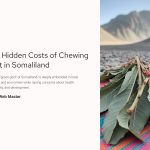 Khat (Catha edulis), often referred to as “green gold” in Somaliland, is more than just a stimulant plant — it’s a way of life. Its leaves, chewed for their amphetamine-like effects, are deeply embedded in local traditions and economies. However, as the world shifts toward global health awareness and economic resilience, khat is becoming a focal point of controversy. While it supports thousands of farmers and traders, its socio-economic and health-related downsides are drawing growing concern from policymakers and researchers alike. With Somaliland’s youth increasingly drawn into daily khat use and the nation’s GDP intertwined with its trade, the implications go far beyond personal choice. In this post, we’ll explore the full picture — from khat’s agricultural spread to its unintended consequences on households, governance, and national development. Stay with us to uncover what’s at stake, and how understanding khat today might shape Somaliland’s future tomorrow.
Khat (Catha edulis), often referred to as “green gold” in Somaliland, is more than just a stimulant plant — it’s a way of life. Its leaves, chewed for their amphetamine-like effects, are deeply embedded in local traditions and economies. However, as the world shifts toward global health awareness and economic resilience, khat is becoming a focal point of controversy. While it supports thousands of farmers and traders, its socio-economic and health-related downsides are drawing growing concern from policymakers and researchers alike. With Somaliland’s youth increasingly drawn into daily khat use and the nation’s GDP intertwined with its trade, the implications go far beyond personal choice. In this post, we’ll explore the full picture — from khat’s agricultural spread to its unintended consequences on households, governance, and national development. Stay with us to uncover what’s at stake, and how understanding khat today might shape Somaliland’s future tomorrow.

The Agricultural Backbone: How Khat Shapes Rural Economies
Khat farming is the economic lifeline for many in Somaliland. Unlike traditional crops, khat requires less water and offers quicker financial returns, making it an attractive option for farmers facing arid conditions. Entire communities rely on its cultivation, from harvesting to roadside retail. The plant’s profitability ensures daily income, which is rare in regions with limited infrastructure and financial access.
However, this economic dependency can come at the cost of food security. Fields once used for vegetables or grains are now dominated by khat, leading to rising food imports. This crop substitution pushes rural areas further into economic vulnerability, especially when market fluctuations or government interventions affect khat trade. As climate change threatens regional agriculture, this overreliance on a single crop with limited nutritional value becomes even riskier.

The High Cost of Daily Chewing: Health and Productivity Impacts
While khat provides a temporary stimulant effect, its long-term health impacts are alarming. Regular users often face insomnia, anxiety, gastrointestinal issues, and even heart complications. In extreme cases, psychological dependence leads to social withdrawal and loss of income due to decreased work performance.
The impact on national productivity is stark. Government studies estimate that workers who chew khat lose 3–5 hours of work daily. In a developing economy like Somaliland’s, such productivity loss has significant repercussions on both individual livelihoods and national GDP. Moreover, youth addiction to khat is becoming a public health crisis, with many school-age children exposed to the habit early.
Read WHO’s mental health insights

Women Left Behind: Gender Dynamics in the Khat Economy
In many Somaliland households, the financial burden of khat falls on women. Men often spend a significant portion of daily earnings on khat, reducing the budget available for food, health, and education. This behavior amplifies gender-based inequality, as women are expected to compensate for household gaps with little economic power themselves.
Moreover, women rarely benefit from khat-related income. While men dominate production and sales, women are typically relegated to lower-income sectors or excluded altogether. This creates a vicious cycle: men earn and spend on khat, while women struggle to sustain the family, further marginalizing their social and financial autonomy.

Political Economy: Governance Challenges in the Khat Trade
The khat industry operates in a gray zone. Though legal and taxed in Somaliland, its informal nature makes it difficult to regulate. Local officials often benefit from khat taxation, leading to reluctance in enforcing reforms. This breeds corruption, weakens governance, and undermines trust in public institutions.
Efforts to regulate the trade, such as limiting sales hours or banning use in schools, often fail due to lack of enforcement and community resistance. The economic incentives tied to khat also mean that any attempt to restrict its trade faces pushback from powerful stakeholders. In this context, addressing khat becomes not just a health issue but a political one, involving deep structural reform.

Environmental Strain: Water Use and Land Degradation
Though khat is drought-resistant, large-scale farming demands more water than expected, especially in dry regions like Somaliland. Intensive irrigation from underground aquifers is depleting water tables, a dangerous trend in areas already facing climate stress. Farmers also use fertilizers and pesticides that harm biodiversity and pollute water sources.
Deforestation to expand khat fields has further degraded ecosystems, disrupting traditional land-use systems that once balanced farming, grazing, and conservation. This environmental damage is not just a rural concern — it affects urban centers through increased food prices, reduced air quality, and water scarcity, all of which threaten future development.

A Future in Balance: Rethinking Policy and Community Alternatives
Solving the khat dilemma in Somaliland requires balancing economic reliance with social responsibility. Encouraging alternative livelihoods through microfinance and vocational training can reduce the pressure on khat farming. Education campaigns highlighting health risks, coupled with public dialogue on the plant’s role in society, are essential.
The gokhat farmingvernment must also take a leadership role in promoting diversification, offering incentives for switching crops and enforcing policies that prioritize public health and environmental sustainability. International partnerships could provide the technical and financial support needed to explore these alternatives without collapsing local economies.
Check UNDP development projects
*Capturing unauthorized images is prohibited*


